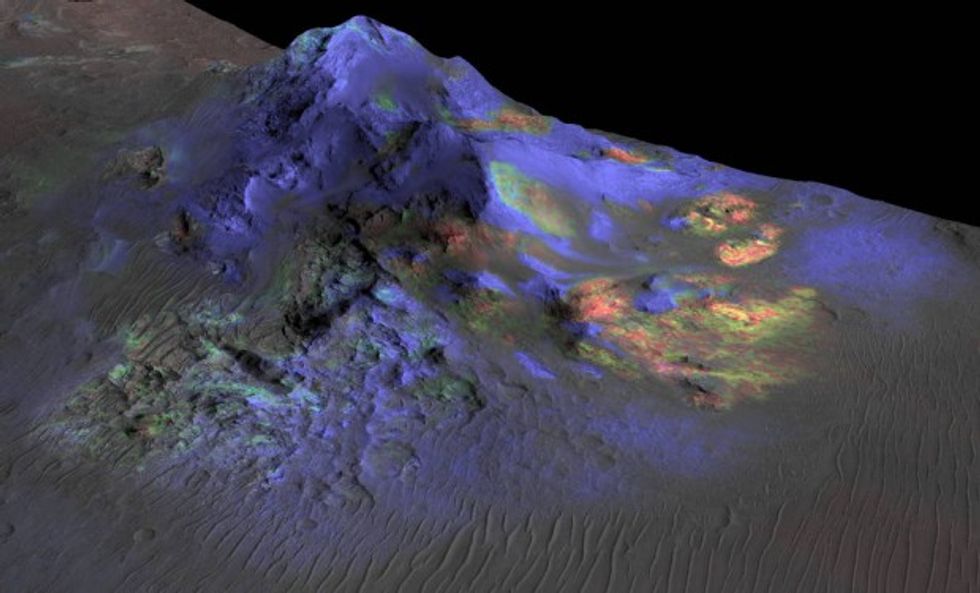
© 2025 Blaze Media LLC. All rights reserved.
"It's possible that some of it might be preserved."
Researchers announced this week that they have identified glass deposits on Mars, and it's something they say could hold evidence of life.
Brown University scientists analyzed data from NASA's Mars Reconnaissance Orbiter to identify glass deposits in impact craters on the Red Planet. The glass deposits themselves are formed by heat caused by the impact of large objects on the planet. This material, researchers think, could hold "biosignatures," which they say could signal life that once was on the planet.
"The work done by Pete [Schultz] and others showed us that glasses are potentially important for preserving biosignatures," Kevin Cannon, a Ph.D. student at Brown and lead author of the new research, said in a statement. "Knowing that, we wanted to go look for them on Mars and that’s what we did here. Before this paper no one had been able to definitively detect them on the surface."

The glass deposits were detected by analysis of spectral signals. Unlike minerals or other rock types that reflect a certain spectra of light, allowing researchers to identify them, glass is harder to spot in this way, a news release from the university explained.
"Glasses tend to be spectrally bland or weakly expressive, so signatures from the glass tend to be overwhelmed by the chunks of rock mixed in with it," co-author Jack Mustard, a professor at the university, said. "But Kevin found a way to tease that signal out."
In a lab, Cannon created a similar type of glass deposit that could be found on Mars and measured its spectral signal. Then he used an algorithm to pick out that specific signal from data collected by the orbiter.
Being able to identify the locations of glass deposits on Mars and knowing that they could hold evidence of life, the researchers said means these sites could be targets for future research.
"If you had an impact that dug in and sampled that subsurface environment, it's possible that some of it might be preserved in a glassy component," Mustard said. "That makes this a pretty compelling place to go look around, and possibly return a sample."
Jim Green, director of NASA's planetary science division, seconded that the relatively common glass deposits could be the subject of future exploration, especially "as our robotic scientific explorers pave the way on the journey to Mars with humans in the 2030s."
The team's research was published in the journal Geology.
In other Mars research news, NASA conducted a test Monday that involved a parachute that could help land spacecraft.
NASA spokeswoman Kimberly Newton said in an email Monday that the parachute deployed but failed to inflate. She says the agency would have more details during a news conference on Tuesday.
The test off the Hawaiian island of Kauai is investigating technology designed to slow down a large landing vehicle as it falls through the atmosphere at supersonic speeds.
The descent started 34 miles above the Earth's surface, where the environment is similar to Mars' thin atmosphere.
Another giant parachute also failed to inflate during a similar NASA test of new Mars spacecraft technology last year.
One of the main goals this year was to test the redesigned parachute.
—
Front page image via Shutterstock.
—
The Associated Press contributed to this report.
Want to leave a tip?
We answer to you. Help keep our content free of advertisers and big tech censorship by leaving a tip today.
Want to join the conversation?
Already a subscriber?
more stories
Sign up for the Blaze newsletter
By signing up, you agree to our Privacy Policy and Terms of Use, and agree to receive content that may sometimes include advertisements. You may opt out at any time.
Related Content
© 2025 Blaze Media LLC. All rights reserved.
Get the stories that matter most delivered directly to your inbox.
By signing up, you agree to our Privacy Policy and Terms of Use, and agree to receive content that may sometimes include advertisements. You may opt out at any time.






